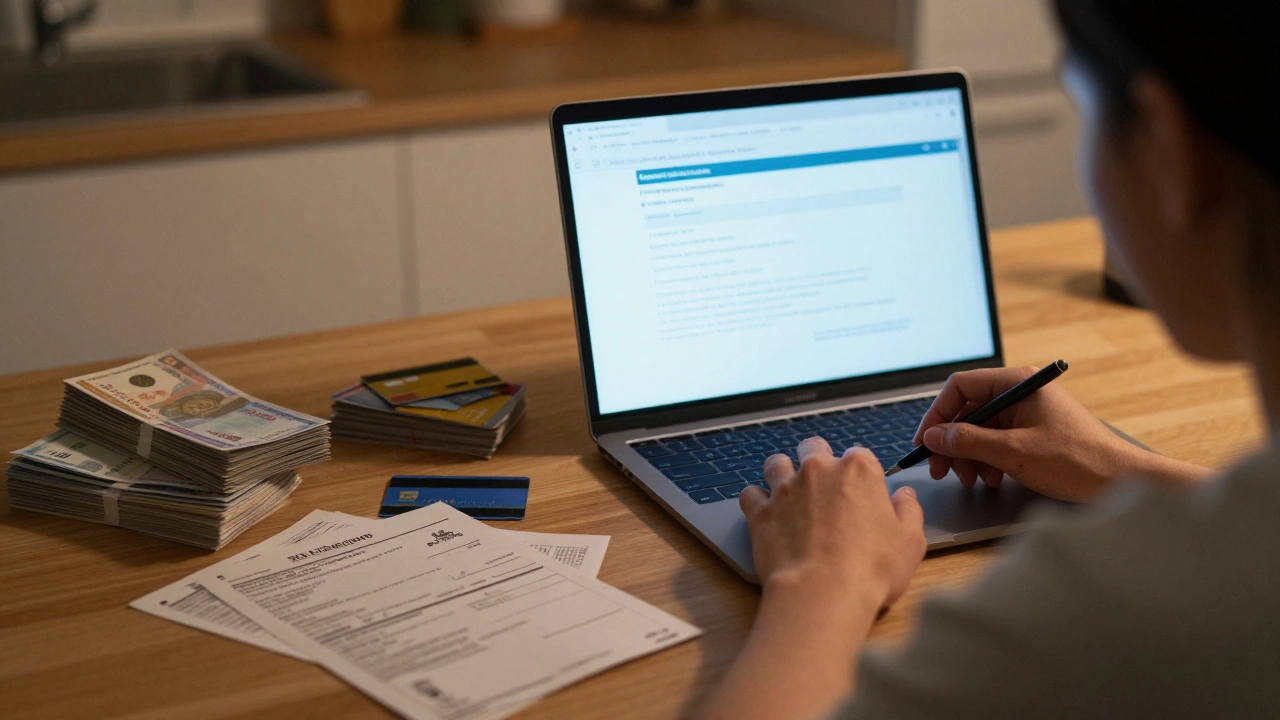Ever stopped to think about what $200,000 in savings really means for most Americans? It's a milestone that could mean a comfy retirement, a nice house down payment, or just a cushion against life's curveballs. But how many people actually hit that mark? Let's break it down.
According to the latest numbers, not as many as you'd think. Only a small percentage of Americans boast such a hefty savings account. It's a goal for many, but a reality for a few. Understanding why this number is significant can help set your own savings path and priorities straight.
Now, why is $200,000 such a big deal? For starters, it's often seen as a tipping point where future financial security starts to feel within reach. It means you've managed to do more than just get by; you've taken steps toward a secured future.
- Understanding American Savings
- Why $200k is a Milestone
- Breaking Down the Statistics
- Barriers to Saving Big
- Practical Tips to Boost Savings
Understanding American Savings
When it comes to savings in America, the landscape is pretty diverse. A report by the Federal Reserve shows that only around 14% of Americans have over $200,000 in savings. This might sound low, but it highlights how difficult building a substantial savings balance can be.
The savings habits of Americans vary widely based on income, education, and even geographic location. Many people save with specific goals in mind—like buying a house, funding college, or preparing for retirement. But unexpected expenses often test these plans, sometimes depleting savings faster than they can be replenished.
Savings vs. Income
One big factor that influences savings habits is income. Higher income earners often have the ability to save more, while those with lower income struggle to save after meeting basic expenses. A staggering number of Americans live paycheck to paycheck, impacting their ability to build any significant savings.
Spending Trends
Americans love to spend, and consumerism plays a key role in savings rates. With the ease of online shopping, staying disciplined can be challenging. Many end up using credit, adding another layer of financial stress. Mindful spending and budgeting help, but it's a skill that requires regular practice.
Interestingly, there's a shift happening as more people become conscious of their financial planning. Technology, like budgeting apps, has made tracking expenses easier, and there's a growing trend toward minimalism, which can positively impact savings rates.
The Role of Education
Education around financial literacy is crucial. Surprisingly, many Americans don’t know how compound interest works, or the benefits of starting early retirement contributions. Programs that teach budgeting and smart financial habits can bridge this gap and empower more to save for the future.
In summary, understanding savings in America means looking beyond the dollar amounts and into lifestyle, decisions, and resources that shape financial behavior. With the right tools and mindset, building a strong savings fund is within reach for more Americans than ever before.
Why $200k is a Milestone
So, what makes hitting that $200k in savings such a big deal? For starters, it's a pretty solid benchmark that represents serious financial stability. When you cross this line, it means you've gone beyond just covering your basics and have started building a real safety net.
First off, let’s talk about retirement. For many, $200k is a major milestone in the quest for a comfy retirement. Sure, it’s not going to cover your entire post-work life, but it’s a significant chunk that together with smart investing, can grow to a solid nest egg.
Then there’s the whole peace of mind factor. Imagine not stressing over unexpected expenses. According to the Federal Reserve, a lot of Americans struggle to cover even a $400 emergency. Having $200k stashed away? That removes a ton of stress and offers freedom to make choices without panic.
Also, having $200,000 or more saved up can really open doors for some exciting opportunities. Whether it's investing in a business, buying a home, or funding an education, having this level of savings gives you options.
Comparative Stats
Let’s take a quick look at some numbers to put things into perspective:
| Age Group | Median Savings ($) |
|---|---|
| Under 35 | 11,200 |
| 35-44 | 36,400 |
| 45-54 | 66,000 |
| 55-64 | 107,000 |
As you can see, not everyone gets there fast. But that’s okay. The point is knowing the goal and working steadily toward it. With some dedication and smart budgeting tips, you can definitely shoot for this milestone.
So, what's the take-home message? Reaching $200k in savings isn't just about having a fat bank account; it's about what it represents — freedom, security, and opportunity. Makes it a goal worth pursuing, right?

Breaking Down the Statistics
So, just how many Americans are sitting on a cool $200,000 in savings? Well, according to recent surveys, not as many as you'd think. In the U.S., roughly 14% of households have at least $100,000 or more stashed away. But when we talk about reaching the $200k milestone, the numbers dwindle even further.
Here's the kicker — only about 6% of adults in the U.S. have managed to save $200,000 or more. That's a pretty exclusive club if you think about how many people there are in the country! But it also highlights how reaching that amount is a tough feat.
The Challenges Behind Saving $200k
Several factors make it challenging. First off, the cost of living varies wildly across states. In high-cost areas like San Francisco or New York City, $200k might seem like small potatoes when monthly expenses gobble up so much.
Then there's the issue of income inequality. A good chunk of Americans are finding it hard just to save a portion of their paycheck, let alone aim for high figures like $200,000.
Income and Age Play a Role
Interestingly, the ability to save big is often linked to age and income bracket. People aged 55 and over, statistically, have more socked away due to working longer and hopefully saving more. But what about today's millennials and Gen Z? Their journey has just begun, and many are still grappling with student loans and starting salaries.
Table of Savings Distribution
| Age Group | Percentage with $200k+ |
|---|---|
| 18-34 | 2% |
| 35-44 | 5% |
| 45-54 | 8% |
| 55+ | 12% |
The table above gives a snapshot view of how savings vary across ages. Notice how it steadily climbs, peaking with those who’ve been in the workforce the longest.
In short, while hitting the $200k mark is significant, it requires a mix of strategic planning, good financial habits, and sometimes, just a little bit of luck.
Barriers to Saving Big
Picture this: You want to stash away that $200k, but life throws so many curveballs, it’s hard to focus on the long-term. Let's chat about what's really standing in the way.
Living Costs
First up, there are the everyday expenses. It's no secret that the cost of living in America can be sky-high, especially in major cities. From housing to healthcare, bills can eat into your paycheck faster than you can say "savings account." It's challenging to save when you're just trying to keep up with rent and groceries.
Debt Loads
Let's not forget about debt—student loans, credit cards, car payments. It's a biggie. Many folks find their income tied up in paying down debt, leaving little room for savings. It’s like being stuck in quicksand; no matter how hard you fight, you’re not moving forward.
Consumer Culture
America loves to buy things, plain and simple. With a consumer culture that encourages spending over saving, it's tough to resist the urge to splurge. Marketing experts know just how to convince us that we need that latest gadget or that must-have fashion item, when really, they just burn holes in our wallets.
Income Disparity
Lastly, let’s talk about income disparity. Not everyone earns a six-figure salary, and for many, just making ends meet is a struggle. This gap makes saving substantial amounts feel impossible.
| Common Barrier | Percentage of Americans Affected |
|---|---|
| Living Costs | 65% |
| Debt | 70% |
| Consumer Culture | 50% |
| Income Disparity | 40% |
Overcoming these barriers isn't easy but recognizing them is the first step. Once you identify what's holding you back, it's easier to make targeted changes.

Practical Tips to Boost Savings
Alright, ready to up your savings game? Let's dive into some down-to-earth, actionable steps that'll help you grow that bank account. We're talking about real ways anyone can increase their savings, not just dreams of a jackpot win.
1. Automate Your Savings
First up, simplify your life with automation. Schedule regular transfers from your checking to your savings account. It feels like the money just disappears – but in a good way. Start with a small amount like $50 a week and gradually increase it. You'll barely notice until you check your account a year later!
2. Trim the Fat
Let’s face it: we all have subscriptions or habits that nibble away at our cash. Take a hard look at your monthly expenses. Do you really need three streaming services or that pricey coffee every morning? Trust me, cutting back here and there adds up faster than you'd think.
3. Set Clear Goals
Savings without a goal is like a road trip without a map. Whether it's $10k or $200k, decide what you're aiming for. It's like having a north star guiding your financial decisions. You'll be less tempted to pull from savings when you know it’s for something big.
4. Challenge Yourself
Try a no-spend week or month to give your savings an instant boost. Sure, it can be tough, but it’s a fun way to see just how much you can stash away. Get creative with free activities and home-cooked meals. Who said saving can’t be fun?
5. Maximize Employer Benefits
If your employer offers a 401(k) match, go for it! That's free money waiting for you. It’s one of the easiest ways to beef up your savings, especially if you’re thinking long term. Every dollar counts, and so do the matching ones.
Summing it all up: saving isn't always about pinching pennies. It's more about making smart choices and using simple strategies to your benefit. And who knows, sticking to these tips just might bring you closer to that magical $200k mark!









